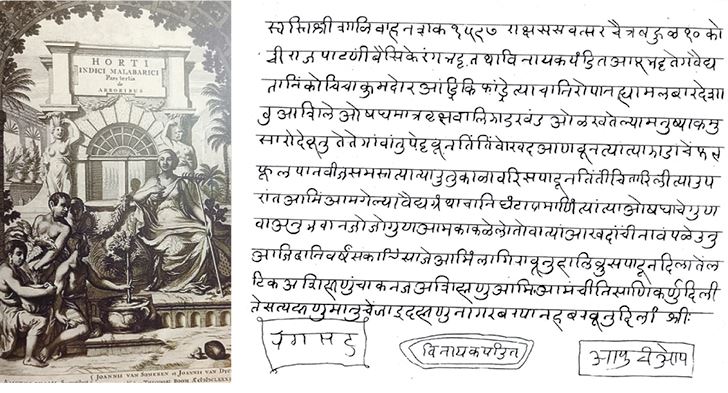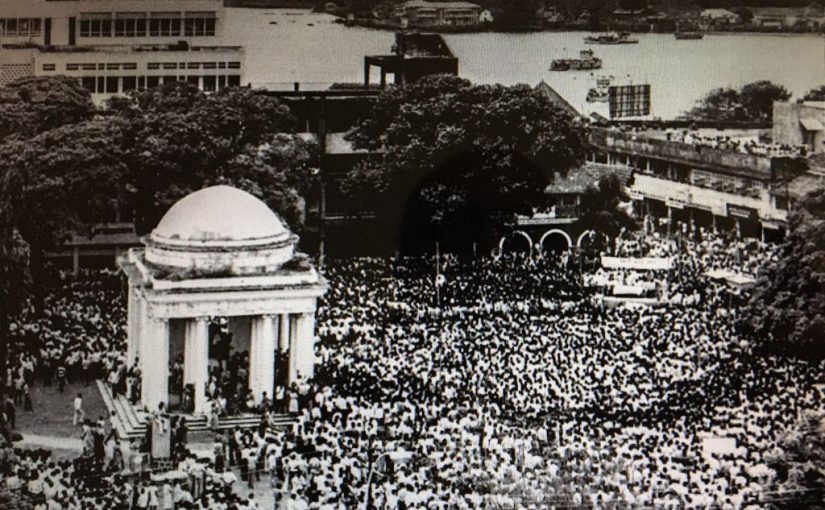By Rajan Narayan
UDAY Bhembre, the chief promoter of Konkani in the Devanagari script, has distorted history in claiming that Konkani is an Aryan language. Bhembre admits that the adoption of the Nagari script to read and write Konkani is only 50 years old. To quote Uday Bhembre “However about 50 years ago the Konkani-speaking community took a conscious decision to use the Nagari to read and write Konkani.”
Prior to this Konkani was written in five different scripts namely Roman, Kannada, Malayalam, PersoArabic and Nagari. Bhembre also admits that the Nagri script was chosen as Konkani was close to Marathi. Uday Bhembre has chosen to ignore the over seven centuries tradition of Konkani being written in the Romi script.
Bhembre acknowledges that the writing of Konkani in the Romi script started with Fr Thomas Stephan who undertook a study of the Konkani language. Fr Thomas Stephan wrote Konkani in the Romi script. Indeed, Thomas Stephan wrote the “Doutrina Christam” in the Roman or Romi Konkani script. Subsequently, a number of writers used the Romi Konkani script. Bhembre makes a very controversial claim that the Portuguese colonial regime ignored writings by Goans. Bhembre even goes to the extent of suggesting that the Europeans considered the locals to be inferior and therefore their works were not worthy of being printed and published.

HISTORICAL TRUTH
THIS is contrary to the historical truth that a large number of books were written in Romi Konkani. This received a boost with the printing press coming to Goa in the 16th century. It has been established that the Roman script for Konkani was widely prevalent in Goa. Bhembre himself concedes that there is been a tradition of using Roman script (meaning English alphabet) for writing Konkani from 1889 when Eduardo Bruno de Souza started the Konkani periodical “Udentechem Sallok.” Bruno de Souza also wrote his first novel, the name of which is not mentioned by Uday Bhembre.
In contrast, the first book in the Nagari script was written and published by Shenoy Goembab as recently as 1910. The group of Devanagari Konkani fanatics who installed Konkani in the Devanagari script as the official language of Goa in 1987 are all part of the Shenoy Goembab group.
Uday Bhembre claims that no objections were raised to the exclusion of the Romi Konkani script in the affirmation of Konkani in the official language act. This is false as even on the day the official language bill was passed there were strong protests from a large group of Romi Konkani activists. In fact, we recall Churchill Alemao who was at the forefront of fighting for Konkani as the state language of Goa had come to the “OHeraldo” office, insisting that “Konkani mai” had been betrayed.
Significantly, Uday Bhembre did not raise any objection to “maushi” Marathi being given equal official language status in the official language bill declaring Konkani in Devanagri script. This is not surprising as Udhay Bhembre belongs to the tradition which considers Marathi the official language of Goa. Laxmanrao Bhembre, the father of Uday Bhembre, was a strong protagonist of Marathi as the official language of Goa. Laxmikant Bhembre also supported the merger of Goa with Maharashtra.
MARATHI LOBBY
AT the time the official language bill was passed the Marathi lobby led by Pratapsingh Raoji Rane was very powerful. Maharashtrawadi Gomantak Party president Ramakant Khalap has admitted that he succeeded in his efforts to get equal official language status for Marathi in the official language bill.
The tragedy of adopting and accepting Konkani in the Devanagari script is that it stunted the growth of the Konkani language. Konkani flourished across Karnataka, present-day Kerala and the in the entire Konkan belt Konkani is written in several scripts. Long before the Devanagari script was imposed on Konkani, there were Konkani literary works in Kannada and Malayalam.
Bhembre himself concedes that the Dutch governor of Cochin, Henric Van Rheede, had written a 12-volume book on the medicinal plants of Malabar in Malayalam Konkani. A wealth of books and periodicals were published in Romi Konkani throughout the Portuguese occupation of Goa for 450 years. It was Romi Konkani which kept the voice of Konkani alive before Liberation.
Uday Bhembre claims that the history of Konkani goes back to the 10th tenth century when some inscriptions were found at the foot of the Bahubali idol at Shravanabelagola in Karnataka. We failed to understand the connection between the inscription on a Jain structure in Karnataka and its link to Devanagari Konkani. The ground reality is that Konkani in the Devanagari script did not exist before 1910.
The decision to adopt Konkani in the Devanagari script was taken by a small group of fanatics without consulting either those using the Romi script or the Kannada and Malayalam scripts. So much so that Nagari (preceding Devanagri script) was an artificial imposition on the Konkani-speaking people.
There is been no growth in the development of Konkani after the adoption of the Devanagari script as the official language. Except for a small group of writers, the second and third generation have not accepted Konkani in the Devanagari script. The vibrant Romi Konkani is evident from the fact that books continue to be written in it. The flourishing Konkiani tiatr is an acknowledgment and recognition of the strength of Romi Konkani. The adoption of Devanagari Konkani officially in Goa has not managed to kill Romi Konkani. On the contrary, the majority of the panchayats in south Goa have demanded granting of equal official language status to Romi Konkani.

BHEMBRE’S SILENCE
THOUGH Uday Bhembre has remained silent on the equal official language status given to Marathi, writer Damodar Mauzo has spoken out. Mauzo has admitted that granting Marathi equal official language status with Devanagari Konkani was a mistake. Goa is the only state in the country where the language of a neighboring state, Maharashtra, has been given equal official language status. Marathi is used for every official purpose for which the use of Konkani has been notified.
The only concession to Konkani is that a knowledge of Devanagiri Konkani is a requirement for government jobs. This discriminates against those who are only familiar with Romi Konkani. The nexus between Devanagari Konkani and the Marathiwadis was exposed by the denial of grants to Diocesan English-medium primary schools by Goa Chief Minister Shashikala Kakodkar in the 1990s.
Uday Bhembre joined hands with Shashikala Kakodkar to block the restoration of government grants to English-medium primary Diocesan schools. Howver, the Catholic church appealed to Manohar Parrikar to restore grants to primary schools run by the Diocesan and other Catholic societies. The irony is that English- medium schools even run by private Catholic trusts like the Rosary School do not now get grants for its primary section.
Similarly, the private Hindu groups which run English-medium primary schools like the People’s High School and Mushtifund do not get government grants for the primary section. The rejection of Devanagari Konkani and Marathi is dramatized by the fact that enrolment in both Marathi-medium and Konkani-medium schools have fallen very sharply.
The Romi Konkani lovers are not demanding the replacement of the Devanagiri Konkani by Romi Konkani as the official language of the state. They are only demanding an amendment to the official language act to give Romi Konkani equal status as the official language. Equal official language status should also be given in the Konkani written in the Malayalam and the Kannada script. The script should not divide the Konkani-speaking people.
There are more Romi Konkani-reading Goans outside Goa than those who read and write Devanagiri Konkani. Hindu families in Goa have traditionally written in Marathi script which became the language of religion and culture through historical compulsion. Even now the bhajan singing during Ganesh Chaturthi or Chavath are in Marathi and not in Konkani. The Devanagari Konkani supporters have not even managed to translate religious books into Devanagari Konkani.
On the other hand the Romi Konkani lovers have been very humble and only want Romi Konkani accepted along with Devanagiri and Kannada and Malayalam as the official scripts of “Konkani-mai” as a mother tongue of the people of the Konkan areas.
